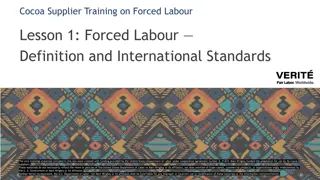
Process of Labour Induction: Risks, Benefits & Methods
Learn about the process of labour induction, including definitions, reasons for induction, associated risks, and methods involved. Discover the importance of induction when necessary for the health of the mother and baby, as well as potential contraindications to consider.
Download Presentation

Please find below an Image/Link to download the presentation.
The content on the website is provided AS IS for your information and personal use only. It may not be sold, licensed, or shared on other websites without obtaining consent from the author. If you encounter any issues during the download, it is possible that the publisher has removed the file from their server.
You are allowed to download the files provided on this website for personal or commercial use, subject to the condition that they are used lawfully. All files are the property of their respective owners.
The content on the website is provided AS IS for your information and personal use only. It may not be sold, licensed, or shared on other websites without obtaining consent from the author.
E N D
Presentation Transcript
StudyMafia.Org Induction of labour Submitted To: Studymafia.org Studymafia.org Submitted By:
Table of Content Introduction Induction of Labour Definition Why is induction recommended? Are there any risks? Contraindications of Induction Induction of Labour Methods Stages of Induction of Labour How It's Done Conclusion
Introduction Induction of labour is performed frequently. The frequency in which induction is performed varies from health care facility to health care facility within regions and within countries. In Canada, induction rates are close to 20%. Done for the correct reasons and in the correct way, induction of labour is useful and benefits the woman and her fetus. If done incorrectly or inappropriately, unnecessary risks may be encountered. The goal is to support as natural a birth experience as possible
Definitions Induction Induction is the initiation of contractions for the purpose of achieving a vaginal birth in a pregnant woman who is not in labour. Augmentation Augmentation is the enhancement of contractions in a pregnant woman who is already in labour. Cervical ripening Cervical ripening is the use of pharmacologic or other means to soften, efface, and/or dilate the cervix to increase the likelihood of a vaginal delivery after labour induction.
Induction of Labour Definition Induction of Labour (IOL) is the initiation of uterine contractions in a woman with intact membrane after the age of viability (28thweek of gestation) and before the onset of natural labour by medical and/or surgical means with the sole purpose of achieving a vaginal delivery.
Why is induction recommended? The most common reasons for induction of labour are the: pregnancy has gone longer than 41 weeks waters have broken but the contractions of labour have not started naturally baby is not well or is not growing well. mother has specific health issues
Are there any risks? There are risks associated with induction. Some women do not want to be induced and will choose to wait and see whether natural labour will start. There are also risks associated with continuing your pregnancy when an induction has been recommended. Before you make a decision, your doctor or midwife will explain the risks of having or not having an induction.
Contraindications of Induction 1. Cephalopelvic disproportion (CPD): when the size of the fetal head cannot pass through the maternal pelvis for whatever reason 2. Previous myomectomy where the endometrium was breached 3. Placenta previa low lying placenta should not be an indication for induction because the woman may bleed to death 4. Active genital herpes: presence of active genital herpes is an indication for C-section and not vaginal delivery
Contraindications of Induction. 5. Malpresentation of the fetus ( such as shoulder, footling, breech, transverse lie) 6. Invasive carcinoma of the cervix 7. Previous uterine rupture 8. Maternal heart disease (NYHA Class III or IV) 9. Two or more lower segment caesarean section 10.One classical caesarean section. 11. Previous Vesico-Vaginal Fistula (VVF)
Induction of Labour Methods 1. Surgical Methods of Labour Induction This is done by Amniotomy using the Amniohook or Kochers forceps or the Alligators Forceps. This is simply the artificial rupture of membranes (ARM) 2. Medical Methods for Induction of Labour Oxytocin infusion; use of Misoprostol (which is a prostaglandin E2analogue and is given as 25 microgram 6 hourly); others are use of Prostglandins E2(PGE2) and Prostaglandin F2a(PGF2a)
Induction of Labour Methods 3. Mechanical methods such as use of Foleys catheter, sweeping of membranes with gloved finger and extra-amniotic saline infusion 4. Unconventional methods of labour induction such as natural methods, use of Acupuncture and homeopathicmethods
How It's Done Stripping the membranes. The doctor puts on a glove and inserts a finger into the vagina and through the cervix (the opening that connects the vagina to the uterus). He or she moves the finger back and forth to separate the thin membrane connecting the amniotic sac (which houses the baby and amniotic fluid) to the wall of the uterus. When the membranes are stripped, the body releases hormones called prostaglandins, which help prepare the cervix for delivery and may bring on contractions. This method works for some women, but not all.
How It's Done Breaking your water (also called an amniotomy). The doctor ruptures the amniotic sac during a vaginal exam using a little plastic hook to break the membranes. If the cervix is ready for labor, amniotomy usually brings on labor in a matter of hours. Giving the hormone prostaglandin to help ripen the cervix. A gel or vaginal insert of prostaglandin is inserted into the vagina or a tablet is given by mouth. This is typically done overnight in the hospital to make the cervix "ripe" (soft, thinned out) for delivery. Administered alone, prostaglandin may induce labor or may be used before giving oxytocin.
How It's Done Giving the hormone oxytocin to stimulate contractions. Given continuously through an IV, the drug (Pitocin) is started in a small dose and then increased until labor is progressing well. After it's administered, the fetus and uterus need to be closely monitored. Oxytocin is also frequently used to spur labor that's going slowly or has stalled.
Risks Failed induction. About 75 percent of first-time mothers who are induced will have a successful vaginal delivery. This means that about 25 percent of these women, who often start with an unripened cervix, might need a C-section. Your health care provider will discuss with you the possibility of a need for a C-section. Low heart rate. The medications used to induce labor oxytocin or a prostaglandin might cause abnormal or excessive contractions, which can diminish your baby's oxygen supply and lower your baby's heart rate.
Risks Infection. Some methods of labor induction, such as rupturing your membranes, might increase the risk of infection for both mother and baby. Prolonged membrane rupture increases the risk of an infection. Uterine rupture. This is a rare but serious complication in which your uterus tears open along the scar line from a prior C-section or major uterine surgery. Very rarely, uterine rupture can also occur in women who had never had previous uterine surgery. An emergency C-section is needed to prevent life- threatening complications. Your uterus might need to be removed.
Risks Bleeding after delivery. Labor induction increases the risk that your uterine muscles won't properly contract after you give birth (uterine atony), which can lead to serious bleeding after delivery.
Conclusion 1. The reasons for induction must be compelling, convincing, and documented. 2. The woman must give fully informed consent. 3. The method should match the situation by considering the degree of urgency of the indication and the status of the cervix. 4. The cervix should ideally be favourable before amniotomy. 5. The woman s preference must be considered.
References Google.com Wikipedia.org Studymafia.org Slidespanda.com
Thanks To StudyMafia.org






















